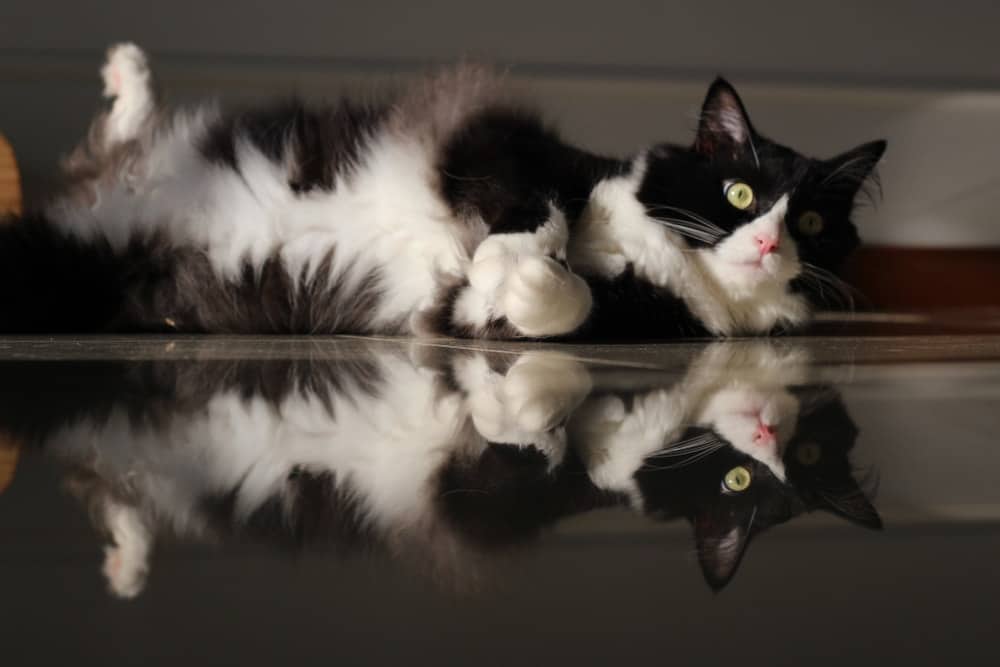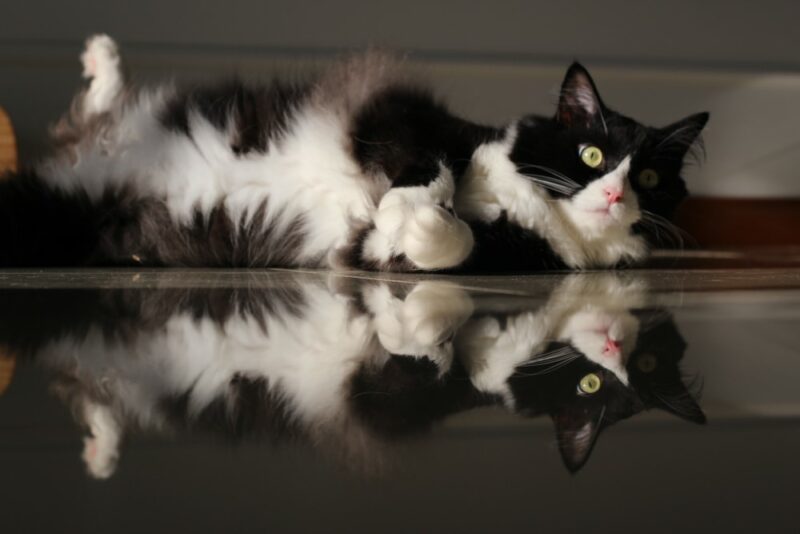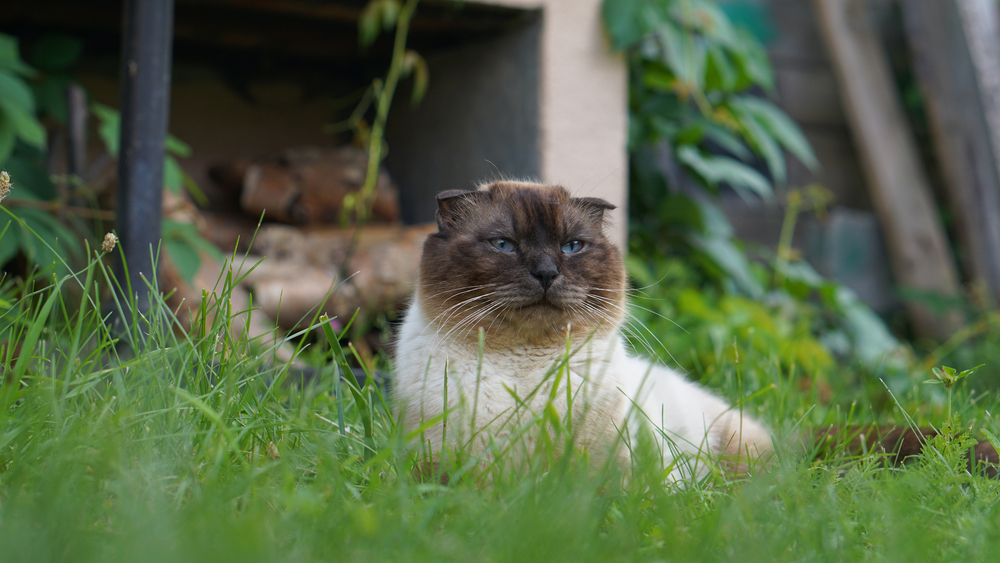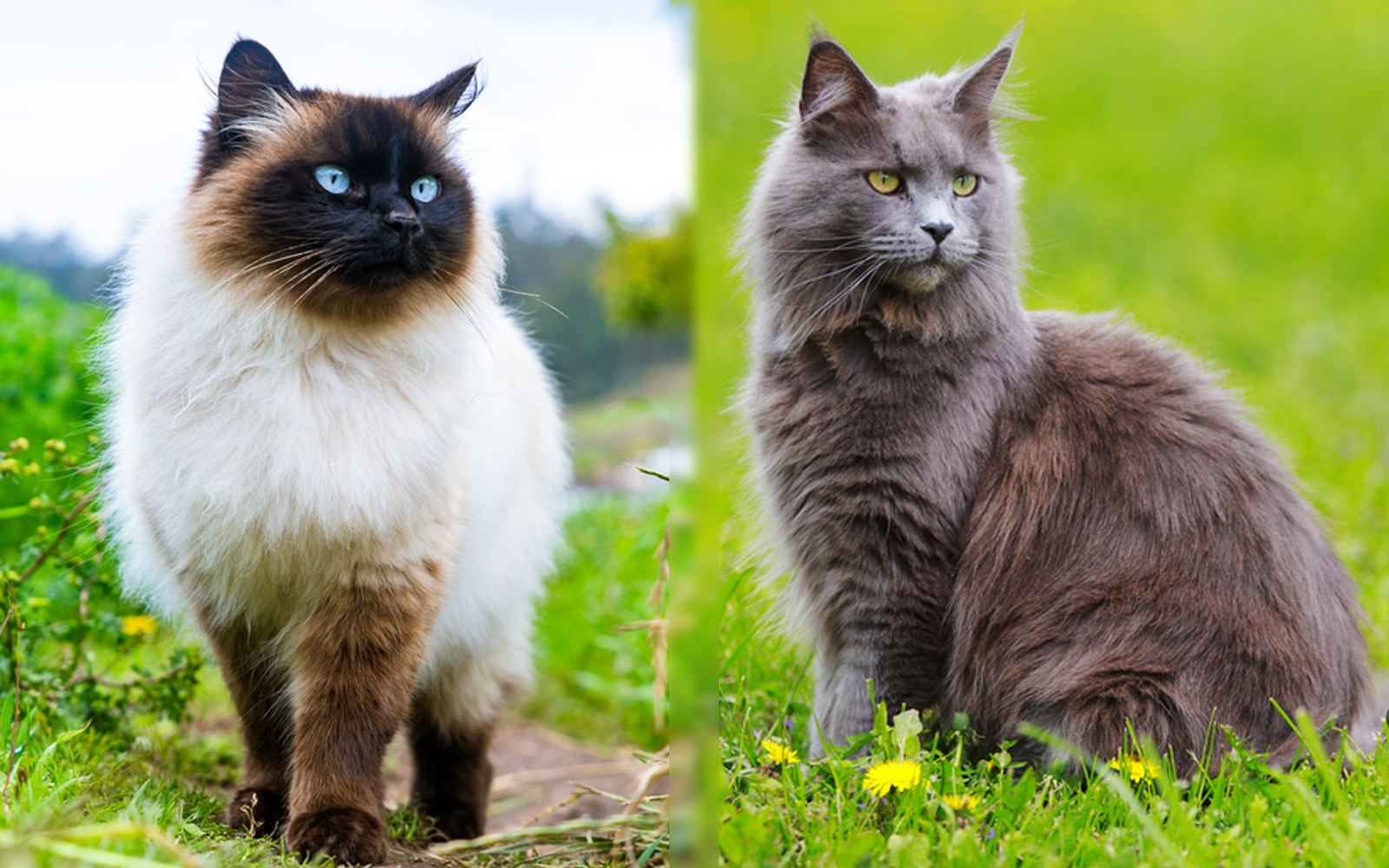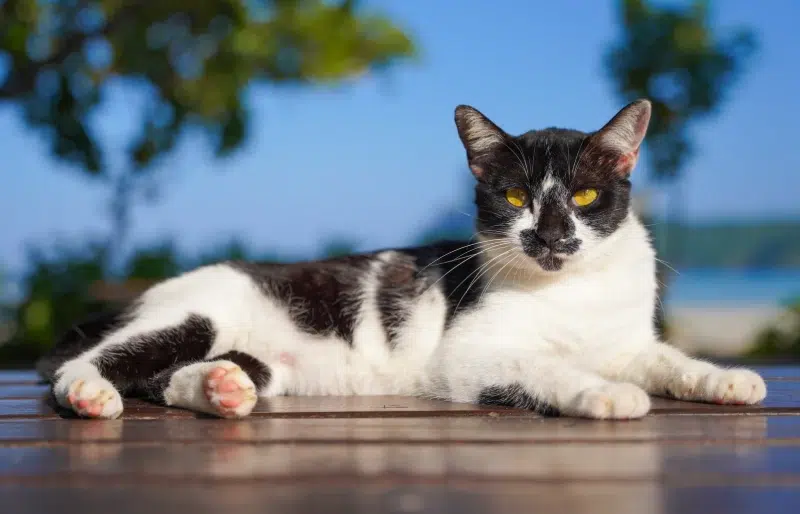Breed Overview
Length:
9–11 inches
Weight:
10–20 pounds
Lifespan:
13–18 years
Colors:
White, blue/gray, silver/lavender, red/orange, brown/chocolate/sable, black/ebony, cream/beige/tan, lilac
Suitable for:
Families with children, first-time cat owners, and homes with other pets
Temperament:
Loyal, friendly, easy to train, easy to groom, happy to be picked up, gets along with other pets
The Ragdoll is a charming, almost larger-than-life cat with stunning blue eyes and a generous disposition. This breed can have many different coat colors and patterns. The term “tuxedo” describes a specific coat color and pattern, with the name giving a clue to its appearance. Kitties with a tuxedo coat have a distinguished air about them and would not look out of place sipping martinis with James Bond!
The black and white bi-color tuxedo coat can be found in many different purebred and mixed-breed kitties. Most cats with this coat are predominantly black with a white chest, neck, face markings, and points, but white can sometimes be the dominant color.
A Ragdoll cat can be a variety of different colors, but if yours is not one of the many colors or patterns listed in the table, they may have mixed heritage. This is unlikely to diminish their delightful personality, however, which is a dominant aspect of the breed.
Ragdolls may have a tuxedo coat together with those signature blue eyes. If so, the eyes could point to pure breeding. However, it’s more likely that their genes have been mixed or diluted somewhere in their ancestry.
The tuxedo coat is common among a huge variety of cat breeds. It is most frequently observed in male cats but is still common in females.
Tuxedo Ragdoll Cat Breed Characteristics
The Earliest Records of Tuxedo Ragdoll Cats in History
The Ragdoll is a fairly recent breed of cat. Their origins can be accurately pinpointed to a Californian woman who bred the first ones in the 1960s. Ann Baker crossed a white Persian female cat with a Birman (or Birman-type) male. The resulting kittens were so unique in looks and behavior that she decided to selectively breed them. They acquired their name from the distinctive way that they go limp and relaxed when they are picked up.
The history of the tuxedo, also known affectionately as a “tuxie,” “Felix cat,” and “Jellicle cat,” is not well documented. This is because it is a color and pattern, rather than a breed.
It’s impossible to say exactly when tuxies first appeared in human society. However, they were certainly already around in ancient Egyptian times, as tomb explorations have revealed.
How Tuxedo Ragdoll Cats Gained Popularity
The tuxedo cat is striking and distinctive, and over the ages, they have been singled out and highlighted in many contexts. Tuxies in popular media began to emerge from the early 1900s. Think about Dr. Seuss’s “The Cat in the Hat,” Felix the Cat, and Sylvester from “Looney Tunes.” Some people claim that tuxies are smarter than cats of other colors!
The Ragdoll breed did not take long to establish themselves as one of the most popular. Given the incredible nature and beauty of these cats, it was inevitable. Much like tuxie lovers, Ragdoll aficionados claim that they are more intelligent than other breeds.
Ragdolls are famously owned by several celebrities. Taylor Swift has a bi-color seal Ragdoll called Benjamin Button. Seth Green, Sylvester Stallone, and Dannii Minogue also adore their Ragdolls.
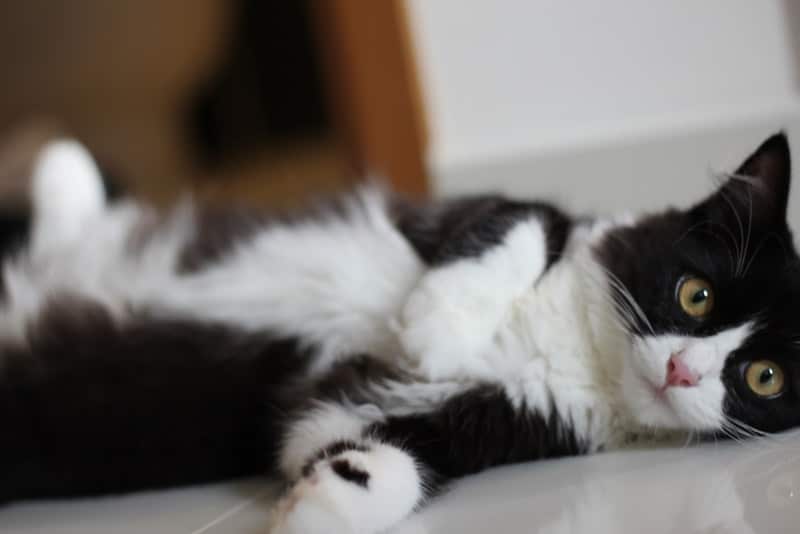
Formal Recognition of Tuxedo Ragdoll Cats
In terms of formal recognition, the tuxedo Ragdoll cat is not one of the recognized variations of the Ragdoll cat breed. However, unless you are intent on showing your Ragdoll, this is inconsequential.
The Cat Fanciers’ Association (CFA), the American Cat Fanciers’ Association, The International Cat Association, and the Cat Fanciers’ Federation only recognize the Ragdoll in specific color and coat pattern variations. Tuxedo Ragdolls are thought to be of impure breeding and as such, are not included in the register.
Top 6 Unique Facts About Tuxedo Ragdoll Cats
1. The Tuxedo Coat Results From the Interaction Between Two Genes
A kitty’s tuxedo coat is thought to result from a random interaction between two genes during embryonic development. This is in contrast to most cat coloration and coat patterns, which result from inheritance. The two genes involved are the one that imparts a black coat and the one that results in white spotting.
2. In 2021, the Ragdoll Was Named the Most Popular Cat Breed in the World
In 2021, the Ragdoll was named the most popular cat breed in the world by the CFA. The people have spoken and we agree!
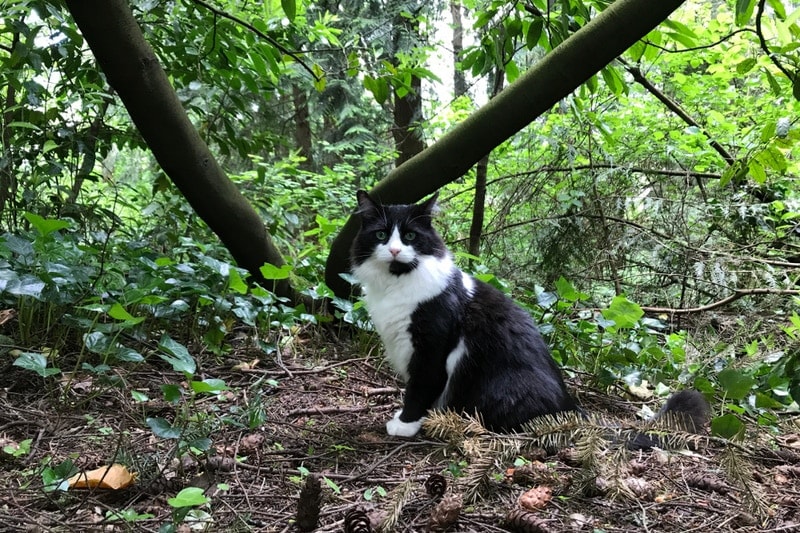
3. Tuxedos Have Been the Pets of Famous Historical Figures
Many famous and important historical figures have kept a tuxie as a pet. William Shakespeare, Sir Isaac Newton, and Beethoven are all said to have owned a tuxedo cat. A tuxie has even lived in the Whitehouse as Bill Clinton’s pet during his term in office.
4. Ragdoll Cats Are at Risk of Developing Hypertrophic Cardiomyopathy
Although they are considered a healthy breed, Ragdolls are genetically predisposed to a heart condition called hypertrophic cardiomyopathy. It is possible to screen for the gene that predisposes a cat to this disease. Consequently, cats in which the gene is identified should be removed from breeding programs.
5. Tuxies Are Said to Be More Intelligent Than Other Cats
It is rumored that tuxedo cats hit developmental milestones earlier than other cats. They may also develop faster than other kittens, both physically and mentally.
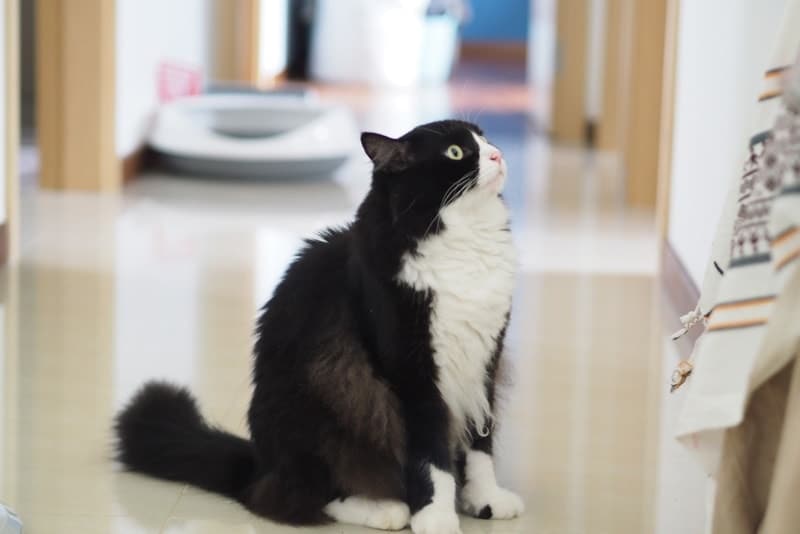
6. Purebred Ragdoll Kittens Are Born Pure White
A purebred Ragdoll kitten will be born pure white. At around 2 months of age, the coat will start to show some color. Their final adult color will only be visible when they are about 2 years old.
 Does a Tuxedo Ragdoll Cat Make a Good Pet?
Does a Tuxedo Ragdoll Cat Make a Good Pet?
Tuxedo Ragdolls, or Ragdolls of any color, for that matter, make the most wonderful pets. There doesn’t seem to be a mean bone in this cat’s body. They simply ooze graciousness and amiability.
They are renowned for being one of the most laidback cat breeds and are tolerant of most environments and situations. Ragdolls are gentle and loyal yet still playful and stealthily mischievous. They are so gentle that they often don’t even extend their claws when playing, even though they play hard. This makes them a great choice for homes with small children.
They are just as fond of other fur members in the family as they are of their humans. It’s impossible to find any real faults with these delightful kitties. As a bonus, they are generally longer-lived than most other breeds, so you’re likely to enjoy your tuxedo Ragdoll for a good long time.

Conclusion
The tuxedo Ragdoll cat may not be officially recognized by any of the feline registration authorities, but we think this is unimportant. The allure of these large, loving felines lies in their agreeable personalities and smart good looks, not their pedigree.
Both tuxedos and Ragdolls are said to be smarter than the average cat. Combined as a package, tuxedo Ragdolls may well possess an intellect that could rival Einstein’s!
If you’re fortunate enough to own a tuxedo Ragdoll, we reckon you’ve hit the kitty jackpot!
See also:
Featured Image Credit: Liao Zhiwo Henry, Shutterstock
Contents
- Tuxedo Ragdoll Cat Breed Characteristics
- The Earliest Records of Tuxedo Ragdoll Cats in History
- How Tuxedo Ragdoll Cats Gained Popularity
- Formal Recognition of Tuxedo Ragdoll Cats
- Top 6 Unique Facts About Tuxedo Ragdoll Cats
- 1. The Tuxedo Coat Results From the Interaction Between Two Genes
- 2. In 2021, the Ragdoll Was Named the Most Popular Cat Breed in the World
- 3. Tuxedos Have Been the Pets of Famous Historical Figures
- 4. Ragdoll Cats Are at Risk of Developing Hypertrophic Cardiomyopathy
- 5. Tuxies Are Said to Be More Intelligent Than Other Cats
- 6. Purebred Ragdoll Kittens Are Born Pure White
- Does a Tuxedo Ragdoll Cat Make a Good Pet?
- Conclusion

